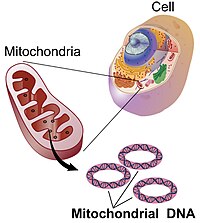
Photo from wikipedia
Abstract The mutational spectrum of the mitochondrial DNA (mtDNA) does not resemble any of the known mutational signatures of the nuclear genome and variation in mtDNA mutational spectra between different… Click to show full abstract
Abstract The mutational spectrum of the mitochondrial DNA (mtDNA) does not resemble any of the known mutational signatures of the nuclear genome and variation in mtDNA mutational spectra between different organisms is still incomprehensible. Since mitochondria are responsible for aerobic respiration, it is expected that mtDNA mutational spectrum is affected by oxidative damage. Assuming that oxidative damage increases with age, we analyse mtDNA mutagenesis of different species in regards to their generation length. Analysing, (i) dozens of thousands of somatic mtDNA mutations in samples of different ages (ii) 70053 polymorphic synonymous mtDNA substitutions reconstructed in 424 mammalian species with different generation lengths and (iii) synonymous nucleotide content of 650 complete mitochondrial genomes of mammalian species we observed that the frequency of AH > GH substitutions (H: heavy strand notation) is twice bigger in species with high versus low generation length making their mtDNA more AH poor and GH rich. Considering that AH > GH substitutions are also sensitive to the time spent single-stranded (TSSS) during asynchronous mtDNA replication we demonstrated that AH > GH substitution rate is a function of both species-specific generation length and position-specific TSSS. We propose that AH > GH is a mitochondria-specific signature of oxidative damage associated with both aging and TSSS.
Journal Title: Nucleic Acids Research
Year Published: 2022
Link to full text (if available)
Share on Social Media: Sign Up to like & get
recommendations!